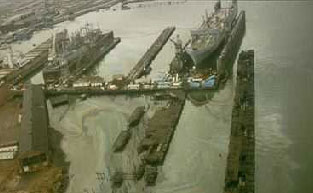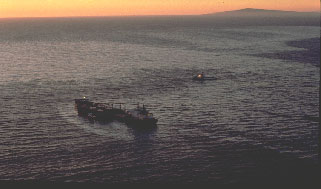The California Coastal Commission Oil Spill Program is part of the Energy, Ocean Resources and Federal Consistency Division of the California Coastal Commission. Our roles in oil spill prevention, preparedness and response in California are diverse and challenging. The Commission's Oil Spill Program staff plays a critical role in facilitating statewide planning and coordination. We are committed to assisting federal, state and local agencies, citizens' groups, and the petroleum industry avoid the potentially catastrophic environmental and economic effects of a large-scale oil spill on the California coast, and ensure that when spills do occur, environmental impacts are reduced to the greatest extent possible.

Our authority is prescribed primarily in two statutes: California Coastal Act of 1976 and the Lempert-Keene-Seastrand Oil Spill Prevention and Response Act of 1990. The California Coastal Commission also exercises regulatory authority under the Federal Coastal Zone Management Act for all of California’s coastal shoreline areas except for the San Francisco Bay.
Protect, maintain, and where feasible, enhance and restore the overall quality of the coastal zone environment and its natural and artificial resources. Protection against the spillage of crude oil, gas, petroleum products, or hazardous substances shall be provided in relation to any development or transportation of such materials. California Coastal Act, 1976
The Incident Command System is a scalable organizational structure used to manage information and resources relating to a particular event. An event can be anything from a Fourth of July Parade to the Exxon Valdez oil spill. The system establishes a compartmentalized structure to a response effort so that information can be quickly transmitted from the source to the decision-makers, and resources can be deployed and supported efficiently and effectively.
Primary decision-making is done through the Unified Command which is supplied with information through functional groups which include:
These functional groups cover all of the essential elements in any response ranging from response personnel to providing funding and transporting equipment. This system was developed as a part of the National Interagency Incident Management System.
The California Coastal Commission is a regulatory agency with permit authority. It is also a resource protection agency with the staff expertise to provide several types of assistance in the event of an oil spill. Listed below are a few examples of how the Coastal Commission staff may provide assistance to local, state and federal agencies and the responsible party in the event of an oil spill.
Incident Command System Roles
The Coastal Commission Oil Spill Program Staff fill key roles in the Incident Command System for oil spills impacting the California coastal and marine resources. We can provide assistance and information to the Unified Command on agency jurisdictions and permitting which will facilitate expeditious cleanup.
Liaison/Agency Representation
Determine which spill response and clean-up activities require an emergency coastal development permit. Assist with Coastal Commission jurisdictional determinations.
Command - Staff Assistance
CCC Staff are trained in the Incident Command System and can serve as assistants to the Command Staff.
Planning - Situation Unit
CCC Staff has knowledge of coastal and marine resources and can assist in determining the spill response and clean-up options that will avoid or minimize adverse impacts to coastal and marine resources.

To determine whether clean up activities are considered “development” and therefore require an emergency coastal development permit pursuant to the California Coastal Act; For emergency permit purposes, determine whether clean up activities could adversely affect coastal resources; To provide technical, jurisdictional and resource assessment assistance.
The Executive Director of the Coastal Commission can issue an emergency permit for clean-up or repair and maintenance activities determined to constitute development as defined in the Coastal Act. Issuing an emergency permit can be accomplished with a verbal approval on scene or by telephone. Issued to the Responsible Party of the spill, an emergency permit requires compliance with any associated conditions, including the submittal of an application for a follow-up regular coastal development permit within a specific period of time (e.g., 60 days). The Coastal Development Permit will evaluate impacts to the site specifically related to the permitted clean-up or repair and maintenance activity, and not from the oil spill. Completion of the permit process does not interfere with the Natural Resource Damage Assessment (NRDA).
Oil spill response related activities that may require a coastal development permit include but are not limited to: Grading (to level off terrain to a smooth horizontal or sloping surface) or construction within the coastal zone for temporary storage (i.e., storage tank for oil), access roads or staging areas; Grading or clearing vegetation in sensitive resource areas; Berming (to construct a temporary barrier to stop flow of oil or water) a river mouth or a lagoon; Repair of pipelines and facilities under water or near sensitive habitats; Construction of retaining walls as oil spill containment barriers.
Protection of resources: Ensures protection of the resources through conditions and limitations set by the permit. In some instances, the CDP may be the only regulatory mechanism to implement other agencies’ resource protection and mitigation plans. Prevention of future spills: Ensures that damaged facilities are properly repaired to prevent repeated oil spills. Prevention of costly errors: Prevention of potentially costly mistakes during a spill response by limiting resource damage.